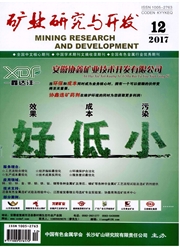

 中文摘要:
中文摘要:
目前岩石动态损伤本构模型未能很好地同时考虑临界应变及已有损伤对被激活微裂纹数目的影响,为此,基于微裂纹在单轴压缩荷载下的扩展机理,提出了新的岩石单轴压缩动态损伤本构模型。在假定岩石中被激活的微裂纹数服从Weibull分布的基础上,首先,通过临界应变对被激活微裂纹数目的影响,建立了考虑临界应变及微裂纹扩展长度的单轴压缩损伤本构关系;其次,根据微裂纹在单轴压缩下的翼裂纹扩展方程,考虑翼裂纹扩展过程中的惯性效应及翼裂纹扩展速度与应变率之间的关系,建立了单轴压缩下岩石动态细观损伤本构模型。最后采用数值算例对模型的合理性进行了验证。结果表明:随着Weibull分布参数k和m的增加,岩石动态抗压峰值强度分布减小和增加,且m的影响更为显著。随着微裂纹摩擦系数、岩石断裂韧性和应变率的增加,岩石动态抗压峰值强度增加;而随着微裂纹长度的增加,岩石动态峰值强度则降低。该结论与目前的研究成果较为一致,说明了该模型的合理性。
 英文摘要:
英文摘要:
The existing dynamic damage constitutive models for rocks do not simultaneously consider the effect of critical strain and existing damage on the number of the activated microcracks very well. Aiming at this shortcoming, a new dynamic damage constitutive model for rocks under uniaxial compression is proposed based on the propagation mechanism of microcracks under uniaxial compression. On basis of the assumption that the number of the activated mieroeraeks obeyed Weibull distribution, the critical strain is firstly introduced to consider its effect on the number of the activated microcracks, and the constitutive relationship of rocks under uniaxial compression was established, which considered the critical strain and the propagation length of the microcrack. Then, according to the propagation equation of the wing crack under uniaxial compression, by considering the inertia effect and the relationship between propagation velocity and strain rate of the wing crack during the process of wing crack propagation, the dynamic microscopic damage constitutive model for rocks under uniaxial compression was set up. Finally, the proposed model was validated with numerical calculations. The results showed that the rock dynamic compressive strength decreased and increased respectively with increasing Weibull parameters k and m, and the effect of m was more significant. With the increase of the microcrack friction coefficient, rock fracture toughness and strain rate, the rock dynamic cornpressive strength increased. While with the increase of the microcrack length, the rock dynamic compressive strength decreased. The results fitted well with the existing research conclusions, which indicated the rationality of the proposed model.
 同期刊论文项目
同期刊论文项目
 同项目期刊论文
同项目期刊论文
 A compressive damage constitutive model for rock mass with a set of non-persistently closed joints u
A compressive damage constitutive model for rock mass with a set of non-persistently closed joints u A Damage Constitutive Model for Rock Mass with Non-persistently Closed Joints under Uniaxial Compres
A Damage Constitutive Model for Rock Mass with Non-persistently Closed Joints under Uniaxial Compres 期刊信息
期刊信息
